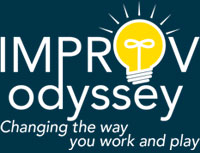Improv – The Long and the Short of It
Short Form and Long Form are the same
The distinction between short form and long form is a development that stems from the going awry or misunderstanding the focus of a game. These terms get bandied about as if they are two separate disciplines. They are not.
Spolin used these games as exercises to help players enter into that space where who, what and where merge into spontaneous theater.
Once players are able to establish and maintain the focus, the game will take as long as it takes. All plays and short scenes are about solving of problems. Scenes have problems that combine to make a play. The play presents a larger canvas to house the individual scenes.
The short form, or simple game, if misunderstood, allows actors to resist the focus and use their heads to make something ‘stage-worthy’. Gimmicks, jokes and the other stuff people complain about in this work is just a simple avoiding of the true focus.
The temptation in a short form is that if nothing develops (you are in your head and panic), go for a joke and get it over with. I think directors and players who want to stop the joking, go for long-form, because the problem presented is larger and that simple idea stops many players from feeling urgent about getting something to ‘happen’ in a small space of time. They then focus on another problem – that of making something cohesive. This could be a valuable focus, if not for the fact that it allows too much time for players to be in their heads i.e., comment, edit, make opinions about how it’s going and then try to insert narrative (usually verbal) elements into the playing to move the whole thing along. Long form allows for too many players to be directors/authors rather than players. In other words, it encourages players to be in their head, rather than connected for extended periods to the fellow players and the solving of the problems (being in the space).
A short game has a simple problem. When that is solved, it is fun theater. A long form may have many problems within it to solve and therefore has the same potential as a short form game. It’s not impossible, but I’ve seen it fail more often than not, for lack of true, constant focus. Intermittent focus does make for good stretches of playing inside a long form, but my experience is that it rarely leaves me feeling jubilant. The feeling I get when I see a series of well played Spolin Games. I feel like I do when coming out of a poorly done “serious piece of theater”, feeling like I should like it more than I do.
Players should approach long and short form with the same idea, to solve the problem of the game. Stay with short form until that happens, break the habit of joking (avoiding the real focus) and then, the challenge of long form will be as vibrant and entertaining as short form improv.
Story should be considered the by-product of good scene work not the goal
Also I disagree with the idea of coping with narrative and story as a primary focus because it puts most players in their heads and disconnects them from true relation with fellow players and obscures the more immediate focus of staying involved with their fellow players, trusting the focus and letting the story unfold.
It is possible to house the elements of narrative inside playing. That takes what Spolin called detachment. Artistic detachment is achieved by having so much focus that the problem no longer occupies the whole self and there is room for seeing the larger picture. This is an advanced state for players and comes easily only to the very gifted, but all players are capable of it after having enough time in the space. Then narrative and things like that occur naturally and do not have to be foremost in a players mind.
Also Spolin had games that approached long form too. Games like “Hold it”, “Theme Scene”, “Scene on Scene” and “Word Game” all hold an evenings worth of play in them.
Del Close, I think saw the natural group mind as always uniting seemingly unrelated things and developed the Harold to prove it. It worked. Unfortunately, I think like Spolin, his work has been boiled down to simpler-to-grasp forms and elemental ideas on how to mechanically get something to happen rather than that ephemeral in-the-space, synergistic connection I imagine he and Spolin were both after.

